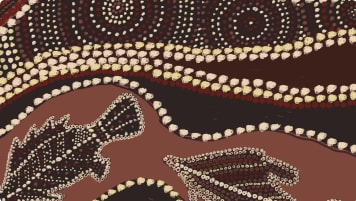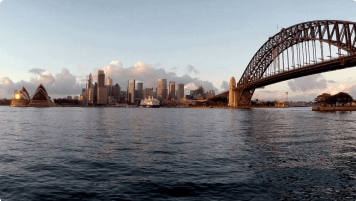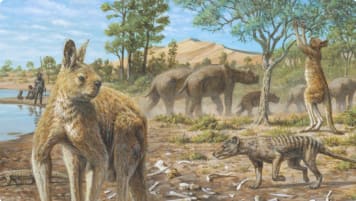The Arrival of Aboriginal Australians on the Continent
Tracing Aboriginal history via an outback small group tour for mature and senior couples or solo travellers provides an intriguing learning platform about Australia, rock art, trading and culture that traces a history possibly some 120,000 years ago.
3 Dec 20 · 7 mins read

Aboriginal Australian Arrival
By Marco Stojanovik
Some Aboriginal Australians have always believed that their ancestors came from across the sea in canoes in the Dreamtime. In northern Australia, for example, one of the major themes in indigenous Creation stories concerns the arrival of the Great Earth Mother, symbol of fertility and creator of life, from across the sea.
In recent years scientists have come to the same conclusion from archaeological and other evidence that Aboriginal people arrived in Australia by watercraft more than 50,000 years ago. It is not possible that human evolution could have occurred in Australia independently of the rest of the world, for the ape-like ancestors from which Homo Sapiens developed in Africa have never been present in Australia. Rather, it is generally held that modern humans, leaving Africa, first reached Asia by 70,000 years ago before moving down through South-east Asia into Australia through a series of hazardous sea voyages in primitive or ancient boats. This first of the Australian Aboriginal population were thus the world’s earliest ocean voyagers.
This article explores the possible routes to Australia taken by the original settlers, watercraft used, and reasons for migration. Much of the information is sourced from Josephine Flood’s Archaeology of the Dreamtime: The Story of Prehistoric Australia and its People. The information is intended as background information for various Odyssey Traveller’s tours of Australia, particularly our tour of Kakadu in the Northern territory – one of the first areas settled by the Indigenous people of Australia.
Related Tours

days
Feb, Mar, May, Jul, Sep +2Guided small group motorcycle tour of World Heritage sites in Victoria and South Australia
Visiting
Discover the World Heritage Sites of the southern states of Australia travelling in a small group tour of like minded motorcyclists. A journey of learning around the southern edges of the Murray Darling basin and up to the upper southern part of this complex river basin north of Mildura. We start and end in Adelaide, stopping in Broken Hill, Mungo National Park and other significant locations.

days
Mar, May, Aug, Sep, Oct +2Small group tour of World Heritage sites and more in the Southern States of Australia
Visiting New South Wales, South Australia
Discover the World Heritage Sites of the southern states of Australia travelling in a small group tour. A journey of learning around the southern edges of the Murray Darling basin and up to the upper southern part of this complex river basin north of Mildura. We start and end in Adelaide, stopping in Broken Hill, Mungo National Park and other significant locations.
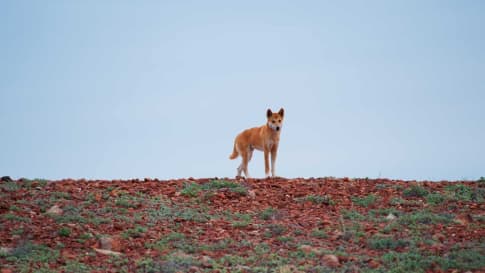
days
Apr, May, Jul, Aug, Oct +2Small group tour of Australia's Flinders ranges
Visiting South Australia
Escorted small group tour of the Flinders range in South Australia from Adelaide. Learn about Coober Pedy, Wilpena pound and water system of Lake Eyre as we explore and learn also about the history of the people who explored the Flinders.

13 days
May, Jun, Jul, Aug, SepSmall group tour of Australia's Kimberley
Visiting Western Australia
Escorted small group tour of the Kimberley. We explore and visit The Bungles, Bell Gorge, Mitchell plateau & Halls Creek in the dry season. Amazing landscapes intertwined with Aboriginal communities resident more than 45,000 years.
From A$15,390 AUD
View Tour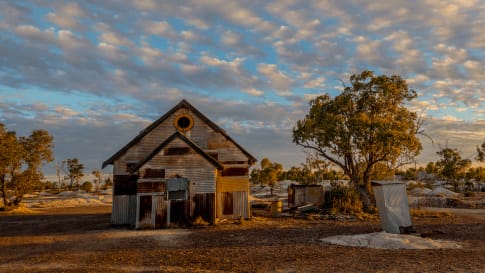
days
Mar, Apr, May, Jul, Aug +2Small group tour of outback Queensland
Visiting New South Wales, Queensland
To Dubbo and back, this small group tour takes you to learn about the Brewarrina fish traps, we travel high up into North Queensland to see the Dinosaurs of Winton and incredible Aboriginal rock art at Cathedral gorge and learn about opal mining and the history of Lightning ridge.

days
Jun, Jul, Sep, Feb, Mar +1Darwin and Kakadu small group tour
Visiting Northern Territory
Explore and learn as part of a small group tour for seniors on this package tour to Darwin and Kakadu National park, a UNESCO world heritage site. This program also visits Arnhem land. Our focus is on ecology, landscapes and history on this 14 day program in the far north of the Northern Territory.
Routes to Australia
Archaeological evidence suggests the first migrations reached Australia by 60,000 years ago during the closing stages of the Pleistocene, when sea levels were much lower than today. The first migrants could not have walked to Australia though, as at no point during the last 3 million years has there been a complete land bridge between the Asian and Australian continents. Although the distance was reduced by lowered sea levels, the earliest travellers would still have had to come across by sea, navigating across large stretches of water.
There is considerable discussion among archaeologists about the route taken. Two likely paths, theorised in 1977 by US anthropologist Joseph Birdsell, are widely accepted and used as a model for researchers.
Birdsell suggested that the most favourable route requiring the least expenditure of energy and resources would have been a northerly one through Sulawesi to New Guinea via a series of smaller islands. New Guinea and the Australian continent were connected as a single landmass known as Sahul until about 10,000 years ago, meaning the first people could walk down through what is now Cape York to the rest of the continent.
Birdsell’s southern route goes through Timor and ends with a significant sea crossing to the Northern Territory or Kimberley coastline. This may have been no more difficult than the first route for both would have involved crossing a maximum of about 90 to 100km of open sea.
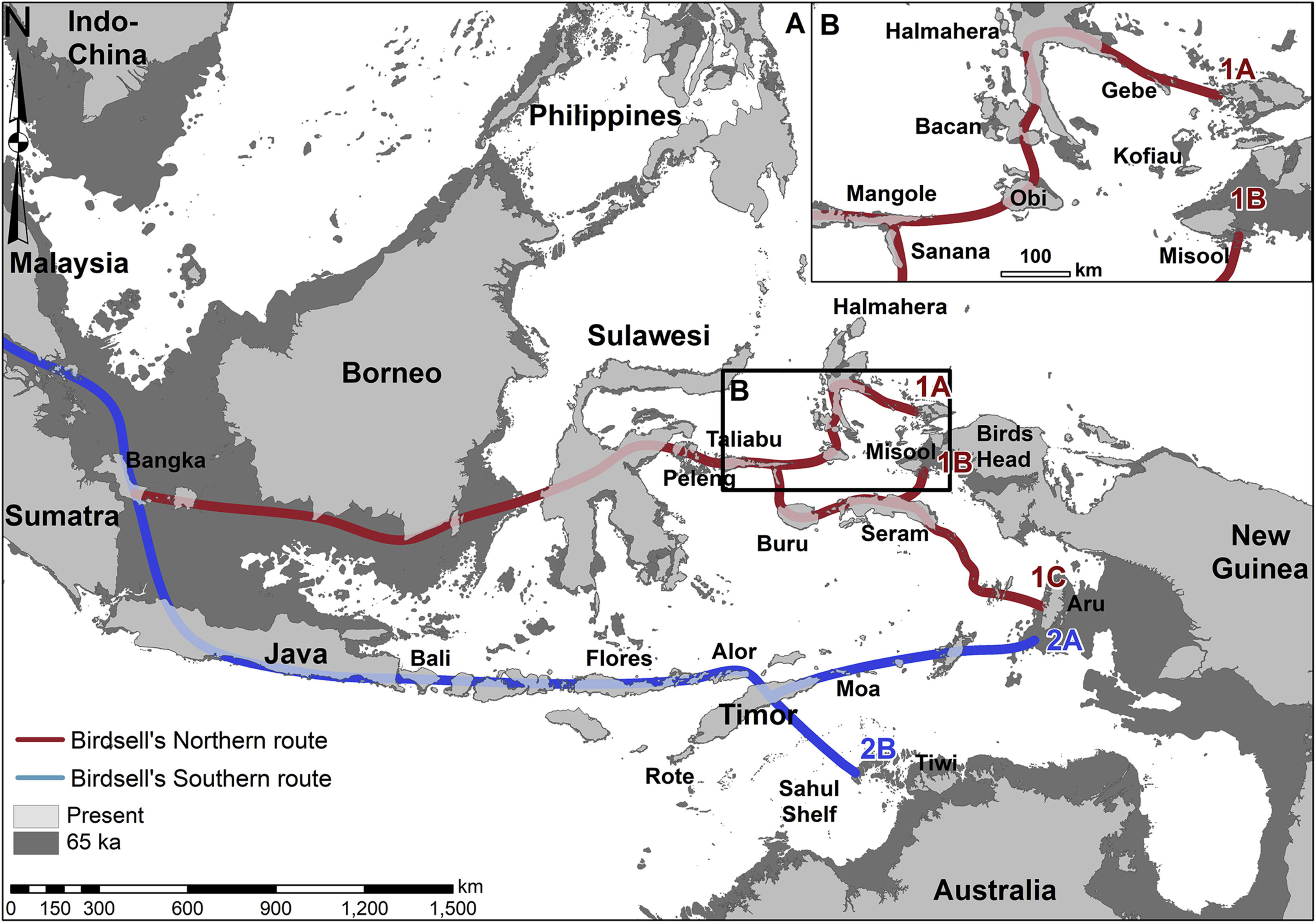
A planned Arrival Using Watercraft
Recent studies have suggested that the ancestors of the Aboriginal, Torres Strait Islander, and Melanesian peoples first made it to Australia as part of an organised, technologically advanced migration to start a new life. They possessed sophisticated technological knowledge to build watercraft, and they were able to plan, navigate, and make complicated, open-ocean voyages to transport large numbers of people toward targeted destinations.
In order to make successful journeys across more than 90km of open sea, the colonists would have needed buoyant and sturdy watercraft. It is likely then that the first voyagers to Australia were coastal dwellers who not only used watercraft such as simple crafts to gather shellfish and other sea foods, but could also already make substantial sea voyages utilising winds and currents.
The lack of preservation of any ancient boat means archaeologists will probably never know what kind of craft was used for the journey, especially as none of the watercraft used by Aboriginals people in prehistoric Australia seem suitable for major Pleistocene voyages.
The most likely suggestion has been rafts or canoes made of bamboo tubes, a material common in Asia, tied together by ropes made from rich Asian flora. Bamboo shafts are coated in silica and are thus impervious to water and extremely buoyant. Bamboo would have grown in areas of high rainfall all along the northern migration route, and at least as far as Java on the southern route.
Once in Australia the voyagers would have been virtually ‘trapped’ by the lack of bamboo, for only a few relatively thin-stemmed species (such as Bambusa arnhemica) grow in isolated pockets in the northern coastal plains.

Reasons for Migration
The motive and circumstances regarding the arrival of the first Australians is a matter of conjecture. One incentive for deliberate voyages to Australia may have been distant smoke from natural bushfires on the Sahul shelf visible from some Indonesia islands. The vegetation on the shelf at this time is likely to have been semiarid savanna woodland, which is prone to fires caused by lightning. Even small fires in this type of vegetation produce billows of smoke rising to 1000 metres of more, while smoke from large bushfires commonly reaches 5000 metre. Some plumes 1000 metres high could have been seen by people standing at sea level up to 100km away, a good indicated of land ahead.
The flight of birds would have similarly been a sign of a new land and food resources. Seasonal migration of birds from Australia to Timor and from New Guinea to Sulawesi, including the vividly colourful, noisy ‘dollarbird’, would have implied the presence of fresh water, vegetation and probably fish and other game.
In addition to these pull factors, certain push factors also probably operated to encourage migration. Economic historian Noel Butlin has identified population pressure and food scarcity as the most likely ways of explaining the migration process. He argues that population growth occurred in mainland Southeast Asia during the last glacial period due to adequate resource supplies and new technological developments. This population growth could have then led gradually to increasing group size, unmanageable groups, and splintering. Such splintering would have led to dislocation as competing groups were herded south and east, including long-distance movement.
Considerable environmental fluctuation during the glacial period could have also played a role. It is generally believed that in the tropics of Southeast Asia, glacial cold spells caused habitat areas of land to expand during times of very low sea level. This resulted in more food-rich savanna and open woodlands, leading to population growth. When the sea the rose again the habitable area would have shrunk within a few thousand years, leading to stress, possible conflict and intensified migration as people tried to find substitute locations.
Scott Cane in 2013 further conjectured in 2013 that the first wave of migrations may have been prompted by the eruption of Toba. One of Earth’s largest known explosive eruption, this super volcanic eruption occurred around 75,000 years ago at the site of present-day Lake Toba in Sumatra, Indonesia. The Toba catastrophe theory holds that this event caused a global volcanic winter of six to ten years and possibly a 1,000-year-long cooling episode. This may have pushed groups out of the region looking for more habitable land.
Tour of Early Aboriginal Sites
Odyssey Traveller visits a number of early Aboriginal sites as part of our tour of Kakadu and Darwin, one of our many brand new outback and Australia tours. Kakadu is believed to be one of the first areas settled by the indigenous people of Australia, with excavations by University of Queensland researchers at the Madjedbebe rockshelter in Kakadu suggesting that the area was inhabited 65, 000 years ago.These archaeological sites revealed stone axes, seed-grinding tools, stone points (likely used as spear tips), and ochre – the oldest ground-edge stone axe technology in the world.
Kakadu National Park meanwhile is home to an extensive collection of ancient Aboriginal rock art. The park boasts over 5, 000 known rock art sites, with some archaeologists believing that there might be up to 15, 000 total sites in the park. Some of these rock paintings are up to 20, 000 years old, constituting one of the longest historical records of any group of people in the world.
Our Kakadu tours make the most of the many indigenous culture opportunities offered by the park, seeing Aboriginal art and learning about the traditional culture of the Bininj/Mungguy people, who have lived in this country for up to 60, 000 years. The tour also takes in the highlights of Kakadu: the plunge pool (one of the national park‘s most popular swimming holes) and stunning waterfalls of escarpment country; Barramundi Gorge (Maguk) in the Mary River wetlands.
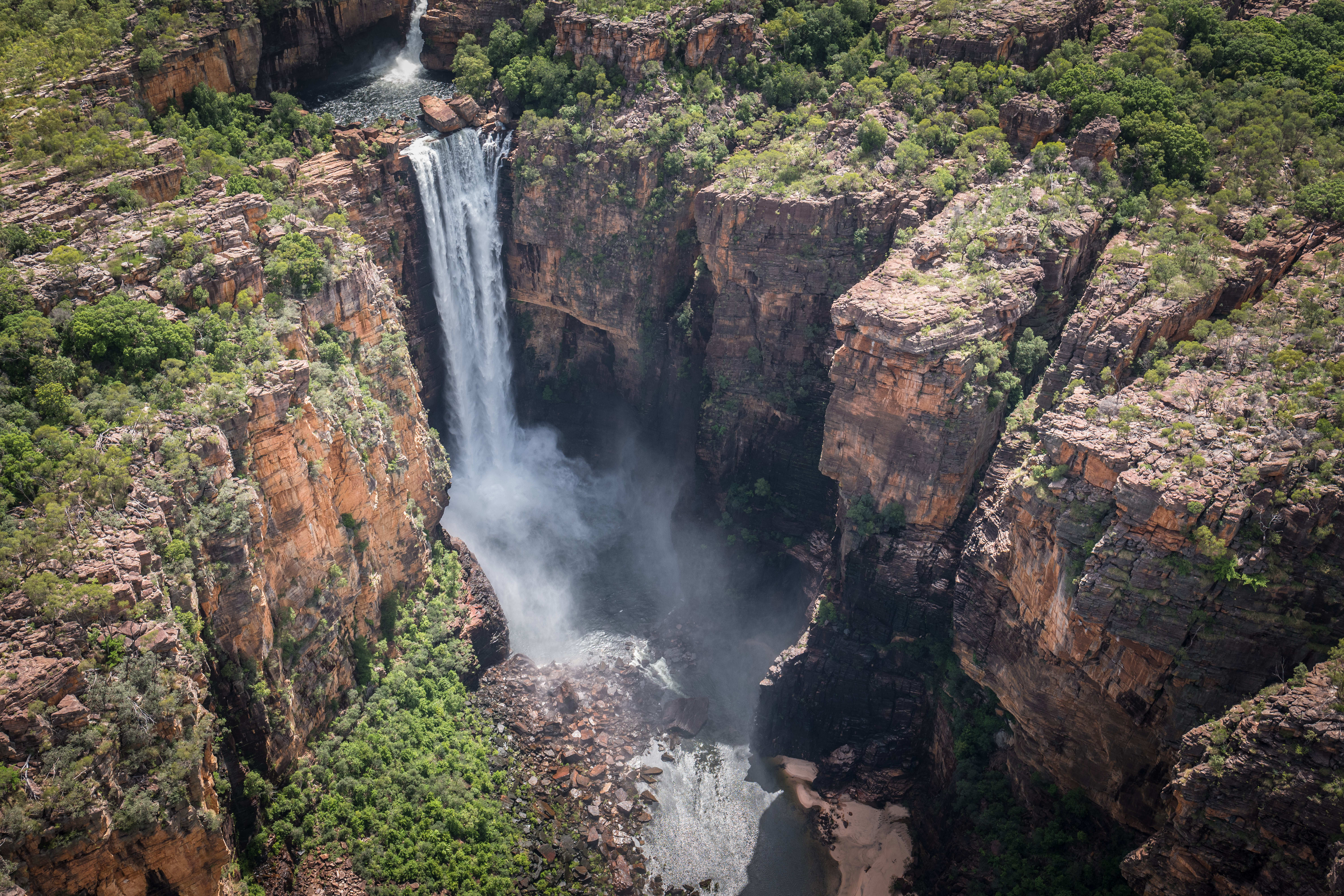
Travellers with an interest in learning more about the Aboriginal heritage of Australia may want to check out our other outback Australia tours, which include visits to the ancient indigenous sites including Lake Mungo and the Budj Bim Cultural Landscape as part of our tour of the Southern States of Australia; visits to the important cultural site of Wilpena Pound on our tour of the Flinders Ranges; to ancient rock art in the Kimberley, Western Australia; and to the Brewarrina Fish Traps in outback Queensland.
Every Odyssey guided tour is designed especially for mature and senior travellers, who want an authentic and informed experience of their destinations. Our tours aren’t the typical tourism Australia holiday – Blue Mountains, the Great Barrier Reef, and the penguin parade on Port Phillip Island. Instead, we pride ourselves on getting of the beaten path and making you think about Australia and New Zealand in new ways. We move in genuinely small groups – usually 6-12 per tour – and all tours are cost-inclusive, encompassing accommodation, attraction entries, and transport. For more information, click here, and head to this page to make a booking.
Articles about Australia published by Odyssey Traveller:
- Uncovering the Ancient History of Aboriginal Australia
- Aboriginal History and Culture of Kakadu National Park
- Aboriginal Land Use in the Mallee
- Understanding Aboriginal Aquaculture
- The Kimberley: A Definitive Guide
External articles to assist you on your visit to Australia:
- UNESCO: Kakadu National Park
- Welcome to Kakadu National Park
- Gunbim: Rock Art
- Birdwatching in Kakadu National Park
- Aboriginal culture in Kakadu (Aboriginal rock art)
- The Met: X-ray Style in Arnhem Land Rock Art
We acknowledge Aboriginal and Torres Strait Islander peoples as the First Australians and Traditional Custodians of the lands where we live, learn and work. We pay our respects to Elders past, present and emerging.
Articles

Aboriginal history and culture of Kakadu National Park, Northern Territory
For those seek to learn as they travel then the history of the Aboriginal journey and timelines that unfold as a discovery in Australia seek to fascinate the mature and senior traveller on a small group package tour for couples and singles. From Darwin, this tour also visits Arnhem land as well as Kakadu, during the dry season.

Aboriginal land use in the Mallee
Learning about the Mallee for a escorted small group tour of South Australia and Western Australia for mature and senior travellers. Understand the Mallee & Wildflowers relationship and the indigenous community land use.

Aboriginal Rock Art in the Kimberley, Australia
The Kimberley is explored on a small group tour for mature and senior travelers, couples or singles. Both Aboriginal community is studied and an appreciation of the wet and dry seasons. This guide on the Kimberley assists the traveler as you start from Broome and travel round via Halls creek and Purnunulu national park over some 17 days in a group of up to 12 people.

Aboriginal Sites of Importance in Outback Queensland, Australia
Outback Queensland is hiding a number of unforgettable indigenous experiences on this small group tour for senior travellers. Especially at the Brewarrina Fish Traps, and Carnarvon Gorge, for example where you can experience and learn about dreamtime creation stories, age-old cultural practices and traditions, and Aboriginal art.

Aboriginal culture of the Flinders Ranges, South Australia
The iconic Flinders Ranges of South Australia have a rich Aboriginal heritage and are home to a number of vitally important cultural sites and ancient artworks that this small group tour for mature and senior travellers has the opportunity its to learn about.

Aboriginal Art
Senior and mature couples and solo travellers remain curious but often informed about the role Aboriginal art plays in the indigenous community and the various styles. This article seeks to provide a platform for this collection of small group tours of upto 15 people into the Australian outback where often Aboriginal art styles are encountered.

Ancient Aboriginal trade routes of Australia
Ancient Aboriginal trade routes of Australia Trade was a central part of life for Aboriginal people prior to the British settlement of Australia. Trading routes criss-crossed the nation, dispersing goods, information, technologies and culture thousands…
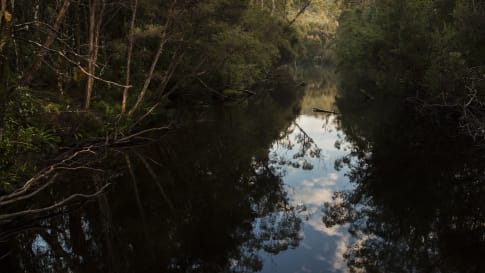
Ice age archaeological sites of the Tasmanian Wilderness World Heritage Area, Australia
Ice age archaeological sites of the Tasmanian Wilderness World Heritage Area, Australia The Franklin-Gordon Wild Rivers National Park is one of the most remote places in Australia, a wild labyrinth of winding gorges, rushing rapids,…

Landscape of Southern Australia from Mallee and Mulga.
Escorted small group tours for mature and senior travellers in Western Australia, Victoria, South Australia & NSW drive through former Mallee country. Article explains the iconic beginnings of Mallee and Mulga in the arid landscapes.

Madjedbebe Archaeological Site, Northern Territory
Madjedbebe Archaeological Site, Northern Territory Near the border of western Arnhem Land and Kakadu National Park in Australia’s ‘top end’, Madjedbebe rock shelter (formerly known as Malakunanja II) is the oldest archaeological site in Australia,…
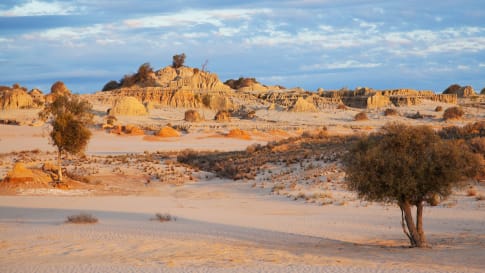
Mungo Man and Mungo Lady, New South Wales
Part of a small group tour of World heritage sites on Victoria, NSW & South Australia for mature and senior travellers. Learn and explore in the Mungo National park about Aboriginal settlement and the fauna and flora of this National park.

The Australian Outback: A Definitive Guide
Explore learn and consider what is the outback in this article. For mature and senior travelers considering joining a small group package tours into the outback to see, learn and explore about this unique place, not only the landscape but the Aboriginal approach to living. On each of the tours for couples and the single traveler you learn something different but fascinating, from Outback Queensland, the Flinders, Broken Hill and the Kimberley and the wildflowers all contribute to this question, what is the outback?

Uncovering the ancient history of Aboriginal Australia
For small group escorted tours of Australia in Queensland, Victoria, New South Wales, South Australia, Tasmania, Western Australia and the Northern Territory a guide on Aboriginal culture for mature and senior travellers.

Understanding Aboriginal aquaculture
Aboriginal communities had the ability to harvest fish some 20,000+ years ago. Creating major centres of trade and cultural exchange, and supported permanent communities. Discover and learn more on a escorted small group package tour to Victoria, South Australia & Queensland for mature and senior travellers, couples and solo travellers interested in learning.
